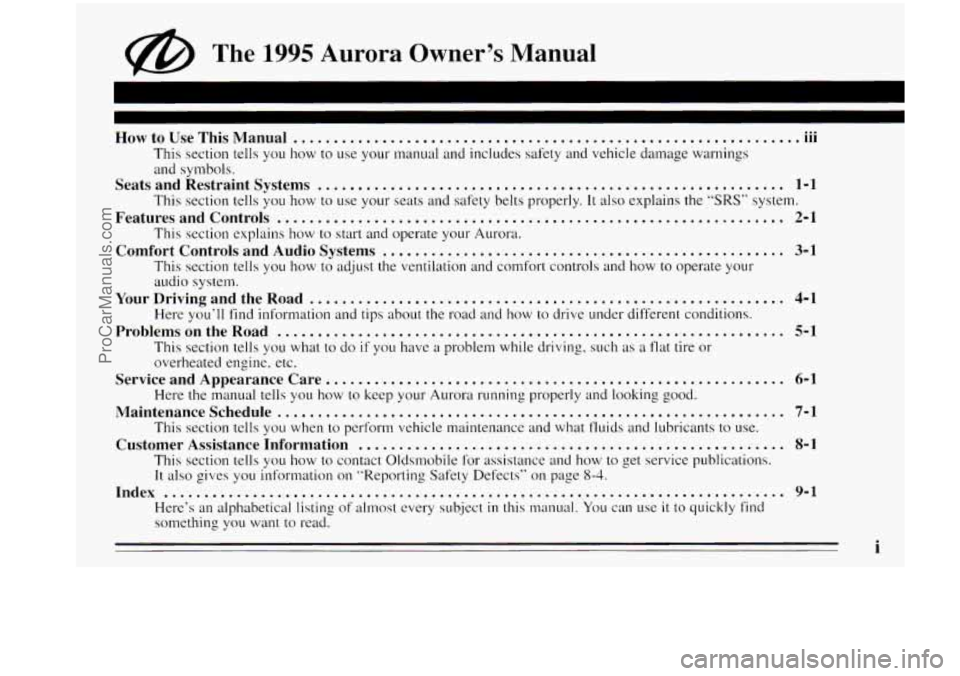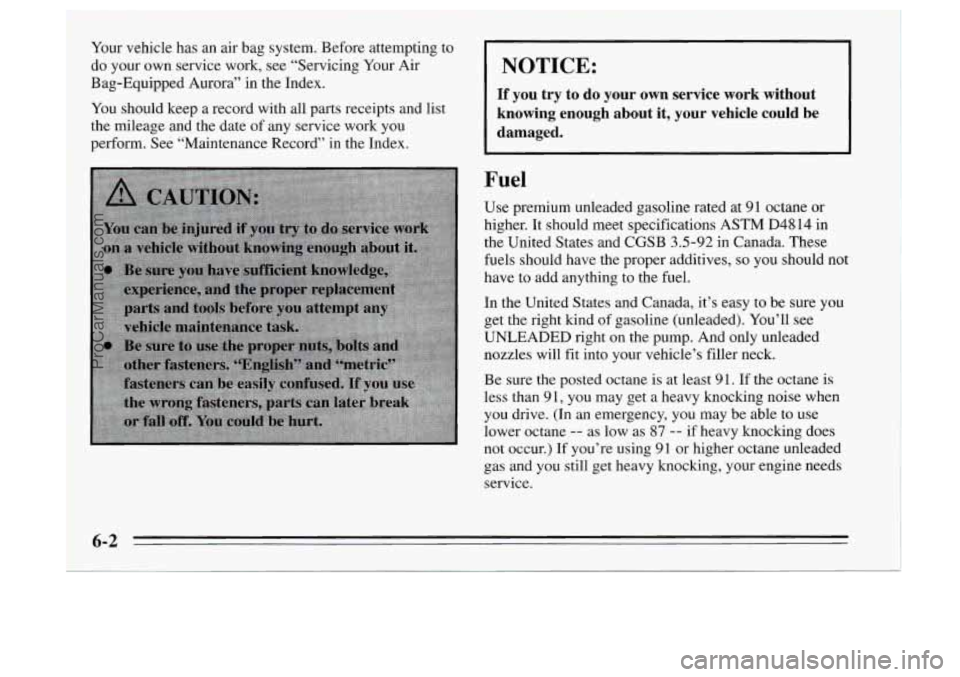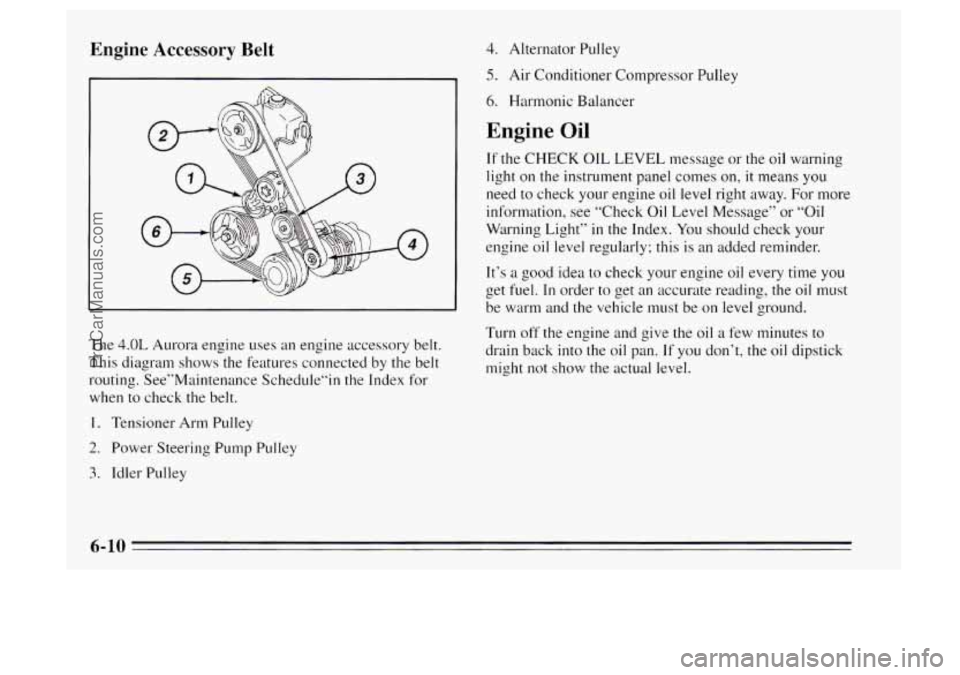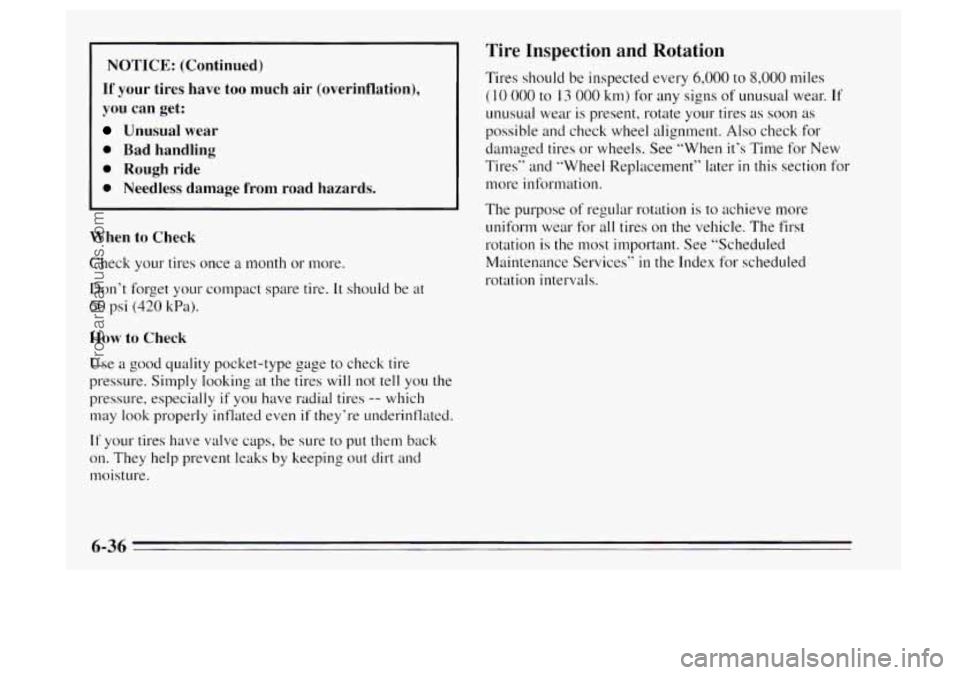maintenance OLDSMOBILE AURORA 1995 Owners Manual
[x] Cancel search | Manufacturer: OLDSMOBILE, Model Year: 1995, Model line: AURORA, Model: OLDSMOBILE AURORA 1995Pages: 372, PDF Size: 19.14 MB
Page 3 of 372

@ The 1995 Aurora Owner’s Manual
... How to Use This Manual .............................................................. .111
This section tells you how to use your manual at~d includes safct/ and vehicle damage warninls
and symbols.
This section tells you how
to use your seats and safcty belts properly. It also explains the “SRS” system.
This scction explains how to start and operate your Aurora.
This section tells you how to adjust the ventilation and comfort controls and how to operate your
audio system.
Here you‘ll I’ind information and tips about the road and how to drive under diffcrcnt conditions.
This section tells
you what to do if’ you ha\:e a problem while driving. such as B flat tire or
overheated enginc. etc.
ServiceandAppearanceCare ......................................................... 6-1
Here the ~nanual tells you how to keep your Aurora running properly and looking good.
Maintenanceschedule ............................................................... 7-1
This section tells you when to perform vehicle maintenance and what fluids and lubricants to use.
Customer Assistance Information ..................................................... 8-1
This section tells ~OLI how to contact Oldsmobile Uor assistance and how to get service publications.
It also gives you information on “Reporting Safety Defccts” on page 8-4.
Index ........................................................................\
..... 9-1
Hcrc‘s an alphabetical listing of almost every sub-ject in this manual. You can use it to quickly find
something yo11 want to read.
Seats and Restraint Systems .......................................................... 1-1
Features and Controls ............................................................... 2-1
Comfort Controls and Audio Systems .................................................. 3-1
Your Driving and the Road ........................................................... 4-1
ProblemsontheRoad ............................................................... 5-1
i
ProCarManuals.com
Page 30 of 372

0 Your vehicle is equipped with a diagnostic module,
which records information about the air bag system.
The module records information about the readiness
of
the system, when the sensors are activated and
driver’s safety belt usage at deployment.
0 Let only qualified technicians work on your air bag
system. Improper service can mean that your air bag
system won’t work properly. See your retailer for
service.
I NOTICE:
If you damage the cover for the driver’s or the
right front passenger’s air bag, they may not
work properly. You may have to replace the
air
bag module in the steering wheel or both the air
bag module and the instrument panel for the
right front passenger’s
air bag. Do not open or
break the air bag covers.
Servicing Your Air Bag-Equipped Aurora
Air bags affect how your Aurora should be serviced.
There are parts of the air bag system in several places
around your vehicle. You don’t want the system to
inflate while someone is working on your vehicle. Your
Aurora retailer and the
1995 Aurora Service Manual
have information about servicing your vehicle and the air bag system.
To purchase a service manual, see
“Service and Owner Publications’’ in the Index.
The air bag system does not need regular maintenance.
ProCarManuals.com
Page 128 of 372

Remember, you must reset the OIL LIFE or TRNS
FLUID yourself after each oil or transaxle fluid change.
It will not reset itself. Also, be careful not to reset the
OIL LIFE or TRNS FLUID accidentally at any time
other than when the oil or transaxle fluid has just been
changed. It can’t be reset accurately until the next oil or
transaxle fluid change.
The Driver Information Center does not replace the need
to maintain your vehicle as recommended in the
Maintenance Schedule in this manual. Also, the oil
change reminder will not detect dusty conditions or
engine malfunctions that may affect the oil. If you drive
in dusty areas, change your oil after every
3,000 miles
(5 000 km) or three months, whichever comes first,
unless the
DIC instructs you to do so sooner. Also, the
oil change reminder does not measure how much oil you
have in your engine.
So, be sure to check your oil level
often.. See “Engine Oil” in the Index.
Check Oil Level Warning
When CHECK OIL LEVEL appears, it indicates that the
engine oil level is
1 to 1 1/2 quarts (0.9 L to 1.4 L) low.
The message will appear only if the engine is running
and it’s been at least eight minutes since the engine was
last running. If the message appears, check the oil
dipstick level. If
it reads low, your oil level should be
brought up to the proper level (see “Engine Oil” in the\
Index). After bringing the oil to the proper level, the
ignition must be
off for eight minutes to allow the
majority of oil to drain into the oil pan.
2-76
ProCarManuals.com
Page 200 of 372

Parking on Hills
You really should not park your vehicle, with a trailer
attached,
on a hill. If something goes wrong, your rig
could start
to move. People can be injured, and both
your vehicle and
the trailer can be damaged.
But if you ever have to park your rig on a hill, here‘s
how to do it:
1.
2.
3.
4.
5.
Apply your regular brakes, but don’t shift into
PARK (P) yet.
Have someone place chocks under the trailer wheels.
When the wheel chocks are in place, release the
regular brakes
until the chocks absorb the load.
Reapply the regular brakes. Then apply your parking
brake, and
then shift to PARK (P).
Release the regular brakes.
When You Are Ready to Leave After
Parking on a Hill
I. Apply your regular brakes and hold the pedal down
while you:
Start your engine:
Shift into a gear; and
Release the parking brake.
2. Let LIP on the brake pedal.
3. Drive slowly until the trailer is clear of the chocks.
4. Stop and have someone pick up and store the chocks.
Maintenance When Trailer Towing
Your vehicle will need service more often when you’re
pulling
a trailer. See the Maintenance Schedule for more
on this. Things that are especially important
in trailer
operation are automatic transaxle fluid (don’t overfill),
engine oil, belt, cooling system, and brake adjustment.
Each of these
is covered in this manual, and ;he Index will
help you find them quickly. If you’re trailering, it‘s a good
idea to review these sections before you stat your trip.
Check periodically
to see that all hitch nuts and bolts
are tight.
4-36
ProCarManuals.com
Page 232 of 372

Your vehicle has an air bag system. Before attempting to
do your own service work, see “Servicing Your Air
Bag-Equipped Aurora” in the Index.
You should keep a record with all parts receipts and list
the mileage and the date of any service work you
perform. See “Maintenance Record” in the Index.
I NOTICE: 1
If you try to do your own service work without
knowing enough about it, your vehicle could be
damaged.
Fuel
Use premium unleaded gasoline rated at 91 octane or
higher. It should meet specifications ASTM D48 14 in
the United States and CGSB 3.5-92 in Canada. These
fuels should have the proper additives,
so you should not
have to add anything to the fuel.
In the United States and Canada, it’s easy
to be sure you
get the right kind of gasoline (unleaded). You’ll see
UNLEADED right on the pump. And only unleaded
nozzles will fit into your vehicle’s filler neck.
Be sure the posted octane is at least 91. If the octane is
less than
91, you may get a heavy knocking noise when
you drive. (In an emergency, you may be able to use
lower octane
-- as low as 87 -- if heavy knocking does
not occur.) If you’re using 91 or higher octane unleaded
gas and
you still get heavy knocking, your engine needs
service.
6-2
ProCarManuals.com
Page 240 of 372

Engine Accessory Belt
The 4.0L Aurora engine uses an engine accessory belt.
This diagram shows the features connected by the belt
routing. See”Maintenance Schedu1e”in the Index for
when to check the belt.
1. Tensioner Arm Pulley
2. Power Steering Pump Pulley
3. Idler Pulley 4.
Alternator Pulley
5. Air Conditioner Compressor Pulley
6. Harmonic Balancer
Engine Oil
If the CHECK 01L LEVEL message or the oil warning
light on the instrument panel comes
on, it means you
need to check your engine oil level right away.
For more
information, see “Check Oil Level Message” or
“Oil
Warning Light” in the Index. You should check your
engine
oil level regularly; this is an added reminder.
It’s a
good idea to check your engine oil every time you
get fuel. In order to get an accurate reading, the oil must
be warm and the vehicle must be on level ground.
Turn off the engine and give the
oil a few minutes to
drain back into the oil pan.
If you don’t, the oil dipstick
might not show the actual level.
6-10
ProCarManuals.com
Page 246 of 372

Refer to the Maintenance Schedule to determine when to
replace the air filter.
See “Scheduled Maintenance Services” in the Index.
NOTICE:
If the air cleaner is off, a backfire can cause a
damaging engine fire. And, dirt can easily get
into your engine, which will damage it. Always
have the air cleaner in place when you’re driving.
Automatic Transaxle Fluid
When to Check and Change
A good time to check your automatic transaxle fluid
level is when the engine oil is changed. Refer to the
Maintenance Schedule to determine when
to change
your fluid. See “Scheduled Maintenance Services” in the
Index.
How to Check
Because this operation can be a little difficult, you may
choose
to have this done at your Aurora Retail Facility
Service Department.
If you do it yourself, be sure to follow all the
instructions here, or you could get a false reading on the
dipstick.
NOTICE:
Too much or too little fluid can damage your
transaxle.
Too much can mean that some of the
fluid could come out and fall on hot engine parts or exhaust system parts, starting a fire. Be sure to
get an accurate reading if you check your
transaxle fluid.
6-16
ProCarManuals.com
Page 248 of 372

3. Check both sides of the dipstick, and read the lower
level. The tluid level must be
in the cross-hatched
area.
4. If the fluid level is in the acceptable range, push the
dipstick back
in all the way.
How to Add Fluid
Refer to the Maintenance Schedule to determine what
kind of transaxle fluid to use. See “Recommended
Fluids and Lubricants”
in the Index.
If the fluid level is low, add only enough of the proper
fluid to bring the level into the cross-hatched area on
the
dipstick.
1. Pull out the dipstick.
2. Using a long-neck funnel, add enough fluid at the
dipstick hole to bring
it to the proper level. It doesn’t
take much fluid, generally less than a pint
(OSL).
DOIZ ’t overfill. We recommend you use only fluid
labeled DEXRON@-111, because fluid
with that label
is made especially for your automatic transaxle.
Damage caused
by fluid other than DEXRON@-111
is not covered by your new vehicle warranty.
After adding fluid, recheck the fluid level as
described under “HOW to Check.’’
0 When the correct fluid level is obtained, push the
dipstick back
in all the way.
ProCarManuals.com
Page 252 of 372

What to Add
Refer to the Maintenance Schedule to determine what
kind
of fluid to use. See “Recommended Fluids and
Lubricants”
in the Index.
NOTICE:
When adding power steering fluid or making a
complete fluid change,
always use the proper
fluid. Failure to use the proper fluid can cause
leaks and damage hoses and seals.
Windshield Washer Fluid
What to Use
When you need windshield washer fluid, be sure to read
the manufacturer’s instructions before use.
If you will be
operating your vehicle
in an area where the temperature
may fall below freezing, use a fluid that has sufficient
protection against freezing. There are
two windshield washer fluid tanks. The upper
tank (shown above)
will empty first. When the lower
tank contains 0.5 quarts (0.5 liters) or less, the message
LOW WASHER FLUID will
be displayed on the Driver
Information Center.
To Add
Open the cap labeled WASHER FLUID ONLY. Add
washer fluid
until the tank is f~111.
6-22
ProCarManuals.com
Page 266 of 372

NOTICE: (Continued)
If your tires have
too much air (overinflation),
you can get:
Unusual wear
0 Bad handling
0 Rough ride
0 Needless damage from road hazards.
When to Check
Check your tires once a month or more,
Don’t forget your compact spare tire.
It should be at
60 psi (420 kPa).
Use a good quality pocket-type gage to check tire
pressure. Simply looking
at the tires will not tell you the
pressure, especially
if you have radial tires -- which
may look properly inflated even
if they’re underinflated.
If your tires have valve caps, be sure to put them back
on. They help prevent leaks
by keeping out dirt and
moisture.
Tire Inspection and Rotation
Tires should be inspected every 6,000 to 8,000 miles
( 10 000 to 13 000 km) for any signs of unusual wear. If
unusual wear is present, rotate your tires as soon as
possible and check wheel alignment.
Also check for
damaged tires or wheels. See “When it’s Time for New
Tires” and “Wheel Replacement” later
in this section for
more information.
The purpose of regular rotation is
to achieve more
uniform wear for all tires on the vehicle. The first
rotation is the most important. See “Scheduled
Maintenance Services’’
in the Index for scheduled
rotation intervals.
6-36
ProCarManuals.com